Attached files
| file | filename |
|---|---|
| EX-99.2 - EXHIBIT 99.2 - Lipocine Inc. | tm2039447d2_ex99-2.htm |
| 8-K - FORM 8-K - Lipocine Inc. | tm2039447d2_8k.htm |

Enabling Oral Drug Delivery to Improve Patient Compliance January 2021 Corporate Presentation Exhibit 99.1

Forward - Looking Statements This presentation contains forward - looking statements about Lipocine Inc . (the “Company”) . These forward - looking statements are made pursuant to the safe harbor provisions of the Private Securities Litigation Reform Act of 1995 . These forward - looking statements relate to the Company’s products and product candidates, FDA’s approval of TLANDO™, the expected timing of Phase 3 trials for TLANDO XR and LPCN 1107 and Phase 2 studies for LPCN 1144 and LPCN 1148 , clinical and regulatory processes and objectives, potential benefits of the Company’s product candidates, intellectual property and related matters, all of which involve known and unknown risks and uncertainties . Actual results may differ materially from the forward - looking statements discussed in this presentation . Accordingly, the Company cautions investors not to place undue reliance on the forward - looking statements contained in, or made in connection with, this presentation . Several factors may affect the initiation and completion of clinical trials and studies, the potential advantages of the Company’s product candidates and the Company’s capital needs . The forward - looking statements contained in this presentation are qualified by the detailed discussion of risks and uncertainties set forth in the Company’s annual report on Form 10 - K and other periodic reports filed by the Company with the Securities and Exchange Commission, all of which can be obtained on the Company’s website at www . lipocine . com or on the SEC website at www . sec . gov . The forward - looking statements contained in this document represent the Company’s estimates and assumptions only as of the date of this presentation and the Company undertakes no duty or obligation to update or revise publicly any forward - looking statements contained in this presentation as a result of new information, future events or changes in the Company’s expectations .

January 2021 Corporate Presentation I Clinical Stage Biopharmaceutical Company Innovative Product Candidates for Metabolic and Endocrine Disorders PRODUCT (Indication) PRE - CLINICAL PHASE 1 PHASE 2 PHASE 3 NDA Propriety Drug Delivery Platform TLANDO™ (Oral Testosterone for Testosterone Replacement Therapy “TRT”) Tentative Approval LPCN 1144 (Oral Testosterone for Non - Cirrhotic NASH ) LiFT Phase 2 Clinical Study Ongoing TLANDO XR (Long Acting Oral Testosterone for Testosterone Replacement Therapy “ TRT” ) Next Step: Food Effect Study LPCN 1148 (Oral Testosterone for Cirrhosis) Next Step: POC Phase 2 Clinical Study LPCN 1107 (Oral HPC for Prevention of PTB) Phase 3 Dose Identified 3 MP184

TLANDO™ The Convenient TRT without Titration Requirement
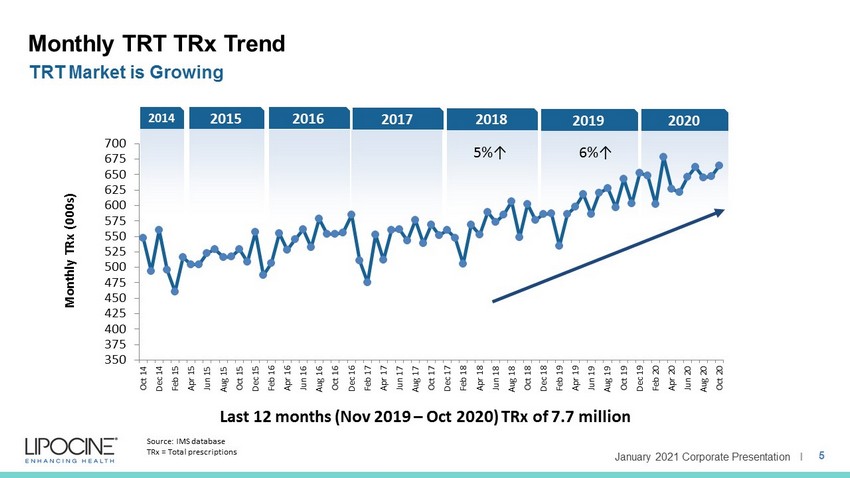
January 2021 Corporate Presentation I 2020 2019 2018 2017 2016 2014 2015 350 375 400 425 450 475 500 525 550 575 600 625 650 675 700 Oct 14 Dec 14 Feb 15 Apr 15 Jun 15 Aug 15 Oct 15 Dec 15 Feb 16 Apr 16 Jun 16 Aug 16 Oct 16 Dec 16 Feb 17 Apr 17 Jun 17 Aug 17 Oct 17 Dec 17 Feb 18 Apr 18 Jun 18 Aug 18 Oct 18 Dec 18 Feb 19 Apr 19 Jun 19 Aug 19 Oct 19 Dec 19 Feb 20 Apr 20 Jun 20 Aug 20 Oct 20 Monthly TRx (000s) Monthly TRT TRx Trend 5 TRT Market is Growing Last 12 months (Nov 2019 – Oct 2020) TRx of 7.7 million Source: IMS database TRx = Total prescriptions 6%↑ 5%↑

January 2021 Corporate Presentation I Issues with Current TRT Options • Black box warning – Secondary exposure to testosterone – Pulmonary oil micro embolism (POME) and anaphylactic shock • Inconvenient application or painful injection • High incidence of erythrocytosis was reported in patients on non - oral – 67% on injectable T, 35% on pellets* • Most require dose titrations - Majority of patients are not on efficacious dose at start of therapy and require up titration – Avg titration time to reach efficacious dose takes 3 - 6 months – Finding appropriate dose through titration is burdensome for physicians and patients – Requires additional clinic/pharmacy visits and invasive samplings • Poor persistence with products requiring titration – 50 - 80% drop off in 3 - 6 months – Insufficient T levels at the beginning of therapy is one of the top reasons patients stop using TRT Potential Barriers To Newly Diagnosed and Existing Patients 6 * Pastuszak et al. Sex Med. 2015
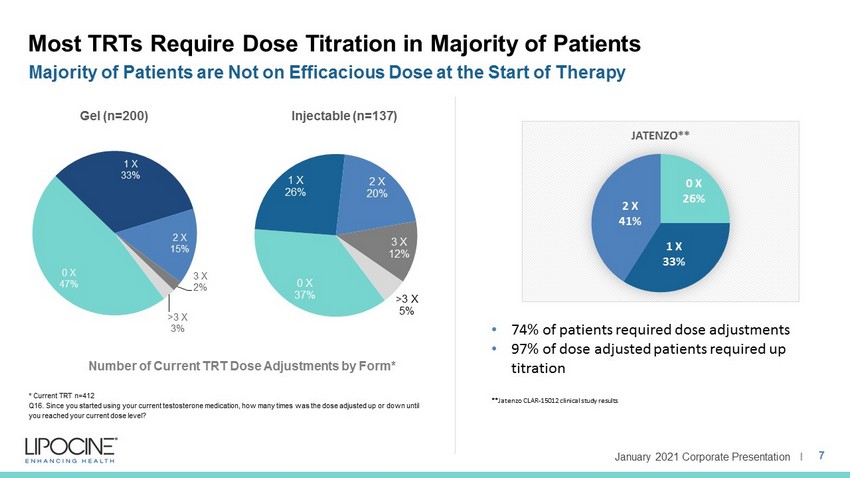
January 2021 Corporate Presentation I 0 X 37% 1 X 26% 2 X 20% 3 X 12% >3 X 5% Most TRTs Require Dose Titration in Majority of Patients Majority of Patients are Not on Efficacious Dose at the Start of Therapy CONFIDENTIAL Number of Current TRT Dose Adjustments by Form* 0 X 47% 1 X 33% 2 X 15% 3 X 2% >3 X 3% Gel (n=200) Injectable (n=137) * Current TRT n=412 Q16. Since you started using your current testosterone medication, how many times was the dose adjusted up or down until you reached your current dose level? 7 0 X 26% 1 X 33% 2 X 41% JATENZO** • 74% of patients required dose adjustments • 97% of dose adjusted patients required up titration ** Jatenzo CLAR - 15012 clinical s tudy r esults
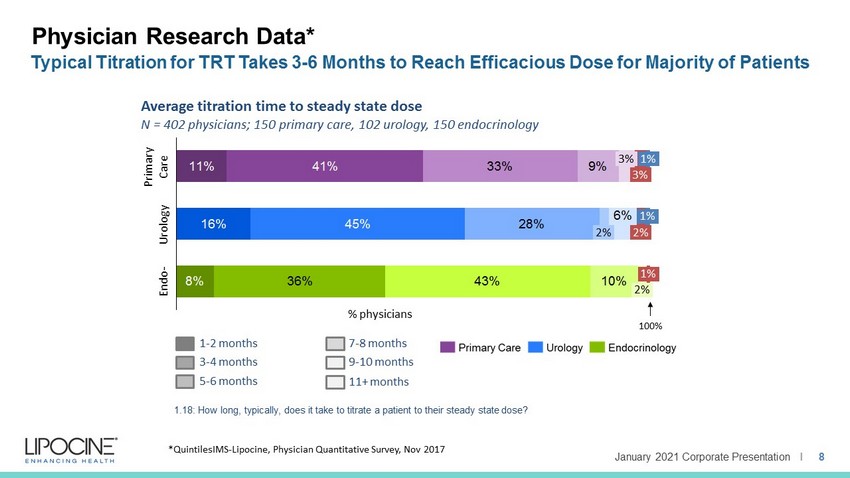
January 2021 Corporate Presentation I Physician Research Data* 8 8 Average titration time to steady state dose N = 402 physicians; 150 primary care, 102 urology, 150 endocrinology 11% 16% 8% 41% 45% 33% 28% 43% 9% 10%36% 6% Primary Care 3% 1% 100% Endo - 2% 2% 1% 2% Urology 3% 1% % physicians 3 - 4 months 5 - 6 months 9 - 10 months 7 - 8 months 1 - 2 months 11+ months 1.18: How long, typically, does it take to titrate a patient to their steady state dose? *QuintilesIMS - Lipocine, Physician Quantitative Survey, Nov 2017 Typical Titration for TRT Takes 3 - 6 Months to Reach Efficacious Dose for Majority of Patients
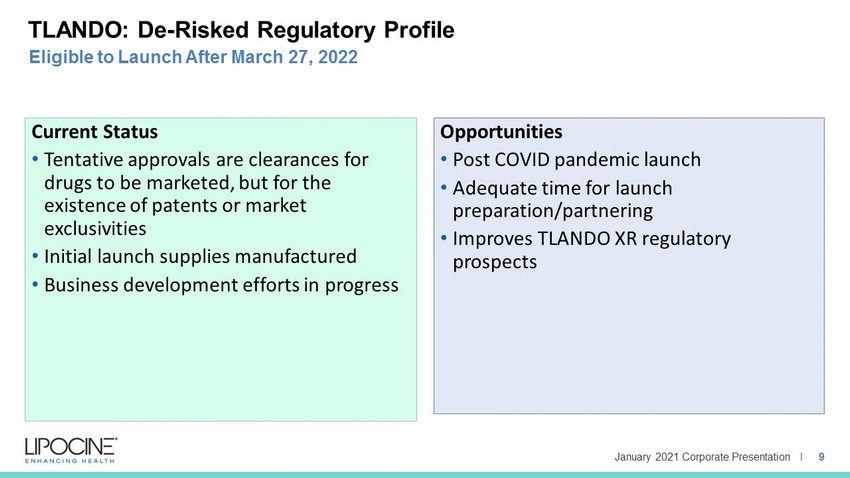
January 2021 Corporate Presentation I TLANDO: De - Risked Regulatory Profile Opportunities • Post COVID pandemic launch • Adequate time for launch preparation/partnering • Improves TLANDO XR regulatory prospects Eligible to Launch After March 27, 2022 Current Status • Tentative approvals are clearances for drugs to be marketed, but for the existence of patents or market exclusivities • Initial launch supplies manufactured • Business development efforts in progress 9
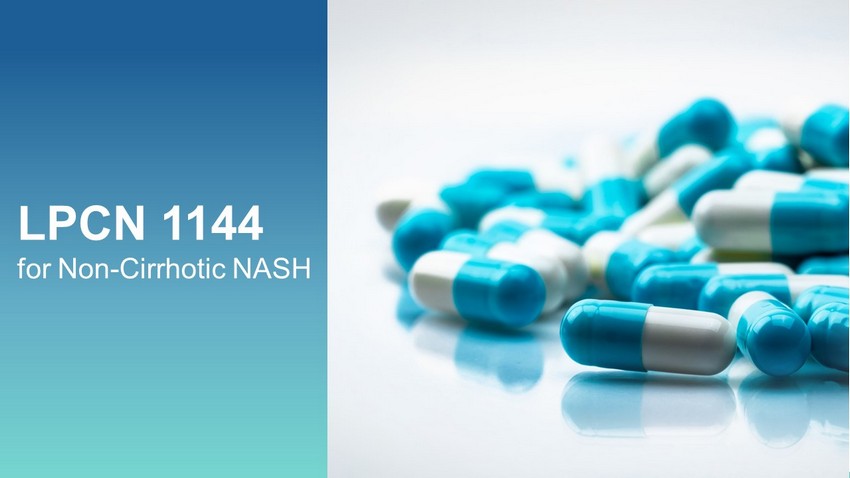
LPCN 1144 for Non - Cirrhotic NASH

January 2021 Corporate Presentation I LPCN 1144: Rationale to Target Non - Cirrhotic Male NASH Patients 11 Currently No Approved Treatment 1. Estes et al., Hepatol 2018. 2. Williams et al., Gastroenterology 2011. *2015 data ~6.9 M Male NASH F2 - F3 in 2030 1,2 17 M NASH Patients 1 11 M NASH Male Patients 1,2 3.5 M Male NASH with F2 - F3 1,2 Multi - billion $ Opportunity* Current Target Population
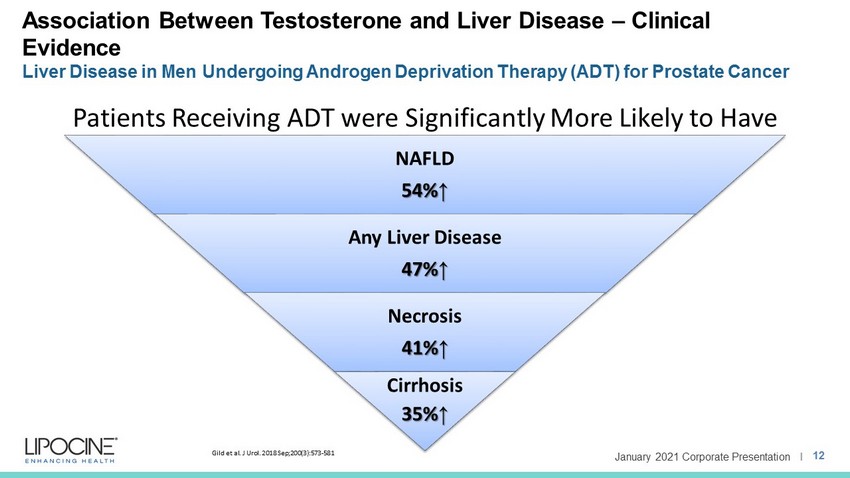
January 2021 Corporate Presentation I Association Between Testosterone and Liver Disease – Clinical Evidence Liver Disease in Men Undergoing Androgen Deprivation Therapy (ADT) for Prostate Cancer 12 Gild et al. J Urol. 2018 Sep;200(3):573 - 581 Patients Receiving ADT were Significantly More L ikely to Have developed any liver disease NAFLD 54% ↑ Any Liver Disease 47% ↑ Necrosis 41% ↑ Cirrhosis 35% ↑

January 2021 Corporate Presentation I LPCN 1144: Androgen Receptor Agonist Differentiated NASH Treatment Candidate Targets Unmet Need Acceptable benefit to risk ratio • NASH resolution and/or fibrosis improvement • Tolerability for chronic use Improvement of sarcopenia Improvement of sexual/mood dysfunction Clinical Experience Non - invasive dosing regimen Meaningfully reduced liver fat in POC study No notable tolerability issues Improved sexual/mood dysfunction 13

January 2021 Corporate Presentation I LPCN 1144: Androgen Receptor Agonist Potential Mode of Action 14 Impact on pro - fibrotic inputs Anti - steatosis Anti - inflammatory Anti - oxidant LPCN 1144 (Oral Testosterone) Regeneration Booster ( ↑ IGF) Impact on fibrosis Anti - fibrosis ( ↓ TGF - β)
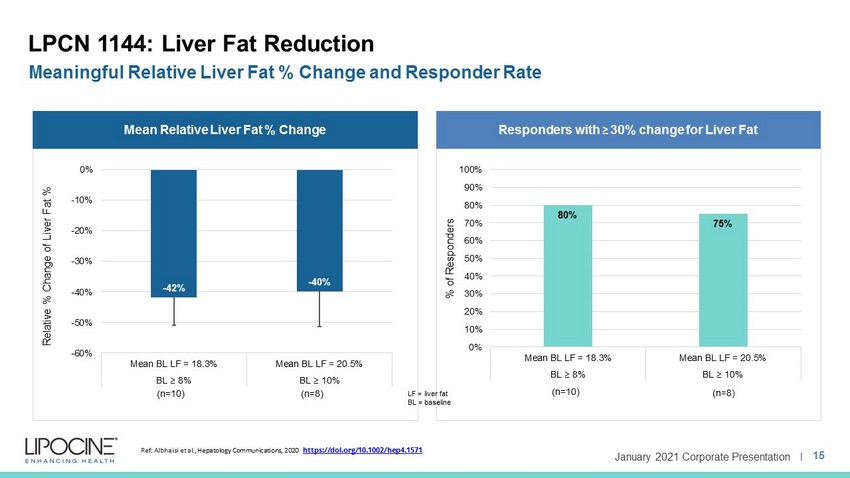
January 2021 Corporate Presentation I LPCN 1144: Liver Fat Reduction Meaningful Relative Liver Fat % Change and Responder Rate - 42% - 40% -60% -50% -40% -30% -20% -10% 0% Mean BL LF = 18.3% Mean BL LF = 20.5% BL ≥ 8% BL ≥ 10% Relative % Change of Liver Fat % (n=10) (n=8) 80% 75% 0% 10% 20% 30% 40% 50% 60% 70% 80% 90% 100% Mean BL LF = 18.3% Mean BL LF = 20.5% BL ≥ 8% BL ≥ 10% % of Responders Mean Relative Liver Fat % Change Responders with ≥ 30% change for Liver Fat (n=10) (n=8) 15 LF = liver fat BL = baseline Ref: Albhaisi et al., Hepatology Communications, 2020 https://doi.org/10.1002/hep4.1571

January 2021 Corporate Presentation I LPCN 1144: LiFT (Liver Fat IntervenTion ) Study* Ongoing 16 Phase 2 Paired - Biopsy Clinical Study in NASH Subjects (NCT04134091) * Website: www.lift - study.com SCREENING Topline MRI - PDFF Results in January 2021 Dose Start Topline Biopsy Results by Mid - 2021 MRI - PDFF, Biopsy Study Design • Three - arm (1:1:1 randomization, two treatments and placebo), multi - center, double - blind • Biopsy confirmed male NASH subjects per arm with NAS ≥ 4, F1 - F3 • Treatment duration of 36 weeks Primary Endpoint • Change in hepatic fat fraction via MRI - PDFF 12 Weeks TREATMENT: 36 WEEKS Secondary Endpoints • Change in NASH activity and fibrosis via liver biopsy scoring • Change in liver markers, anthropomorphic measures (weight, body mass index (BMI), waist to hip ratio, waist circumference), lipids, insulin resistance, inflammatory/fibrosis markers, and labs • Change in quality - of - life degree (SF - 36 and PDQ) and Physical Activity Questionnaire

TLANDO XR (Testosterone Tridecanoate ) Once Daily Oral TRT

January 2021 Corporate Presentation I TLANDO XR: An Innovative Opportunity 18 Next Generation TRT Option Strong IP (new molecule & proprietary drug delivery technology) Positive Phase 2b study results Patients and physicians prefer once a day oral testosterone TLANDO XR is positioned to be the first Oral QD Product TLANDO XR is clinically differentiated from TLANDO
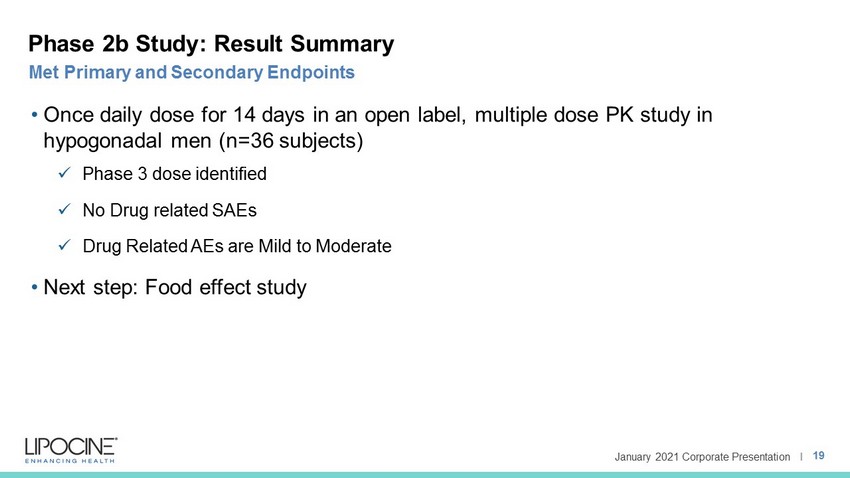
January 2021 Corporate Presentation I Phase 2b Study: Result Summary • Once daily dose for 14 days in an open label, multiple dose PK study in hypogonadal men (n=36 subjects) x Phase 3 dose identified x No Drug related SAEs x Drug Related AEs are Mild to Moderate • Next step: Food effect study 19 Met Primary and Secondary Endpoints
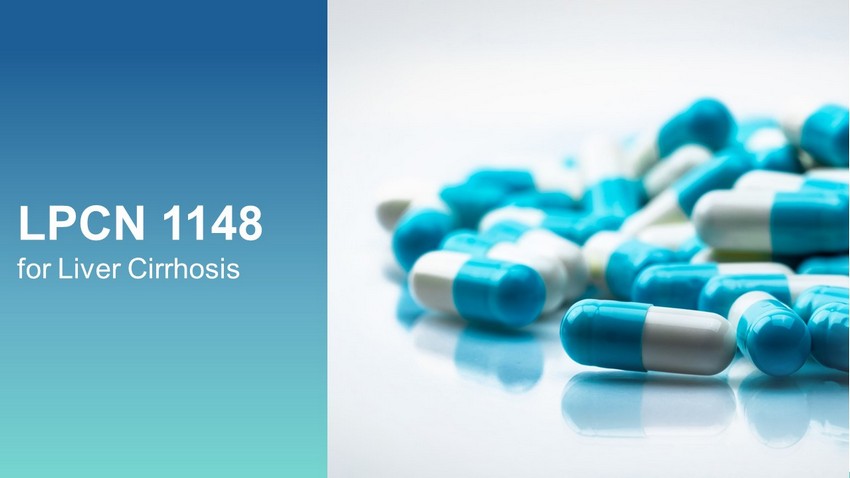
LPCN 1148 for Liver Cirrhosis

January 2021 Corporate Presentation I Common Causes 5 Alcoholic liver disease Nonalcoholic Fatty Liver Disease (NAFLD) Chronic hepatitis B Chronic hepatitis C Cryptogenic LPCN 1148: Oral T for Cirrhosis 21 1. Bentley & Phillips, Milliman Research Report 2017 4. Sarkar et al. J Hepatol. 2015 2. Sinclair et al., Liver Transplantation, 2016; 5. https://www.niddk.nih.gov/health - information/liver - disease/cirrhosis/sympto ms - causes 3. Sinclair et al., J Gastroenterol Hepatol . 2016; Transplant Only Cure for Liver Cirrhosis High Economic Burden of a Liver Transplant 1 Liver Cirrhosis in US Healthy Liver Over 600K patients with liver cirrhosis 2 45K deaths in 2017 3 62% male vs. 38% female on the liver transplant (LT) waitlist 4 Background: Prevalence and Common Causes Liver with Cirrhosis
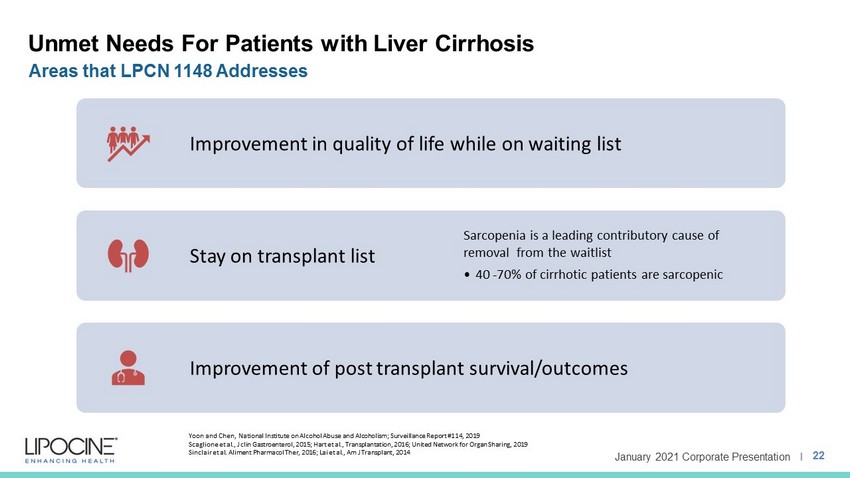
January 2021 Corporate Presentation I Unmet Needs For Patients with Liver Cirrhosis Improvement in quality of life while on waiting list Stay on transplant list Sarcopenia is a leading contributory cause of removal from the waitlist • 40 - 70% of cirrhotic patients are sarcopenic Improvement of post transplant survival/outcomes Yoon and Chen, National Institute on Alcohol Abuse and Alcoholism; Surveillance Report #114, 2019 Scaglione et al., J clin Gastroenterol, 2015; Hart et al., Transplantation, 2016; United Network for Organ Sharing, 2019 Sinclair et al. Aliment Pharmacol Ther , 2016; Lai et al., Am J Transplant, 2014 22 Areas that LPCN 1148 Addresses

January 2021 Corporate Presentation I Sarcopenia in Liver Cirrhosis Equivalent to Adding Significant Points to the MELD Score 23 References: Kim and J.W. Jang, World Journal of Gastroenterology, 2015; Sinclair et al., Journal of Gastroenterology and Hep ato logy (Australia), 2016; Moctezuma - Velazquez et al., Clinical Nutrition, 2018.; Sinclair et al., World Journal of Gastroenterology, 2017. Montano - Loza et al., Clinical and Translational Gastroenterology, 2015; Lai, J.C., et al., Hepatology, 2017; Englesbe et al., J Am Coll Surg, 2010. MELD Score: Model For End - Stage Liver Disease Score A two - fold increase in waitlist mortality/decreased survival Increased risk of hepatic decompensation Increased risk of hospitalization/prolonged hospitalization Poor post - transplant outcomes Increased risk of Infections Malnutrition 23
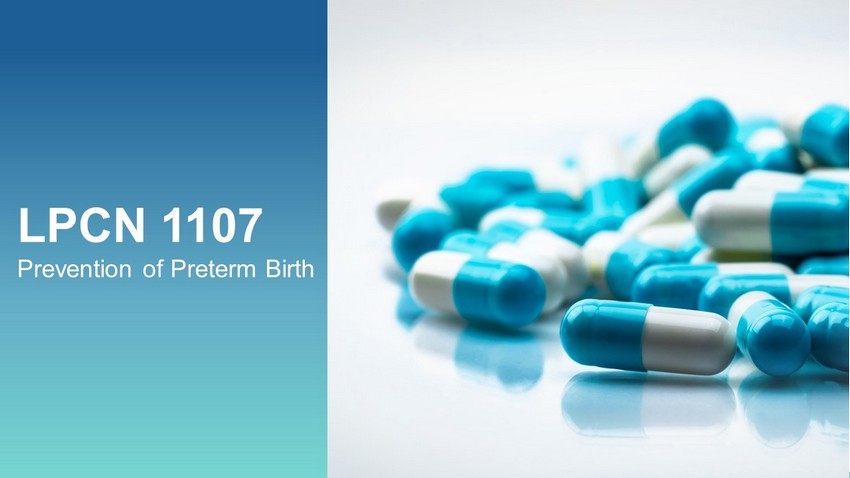
LPCN 1107 Prevention of Preterm Birth
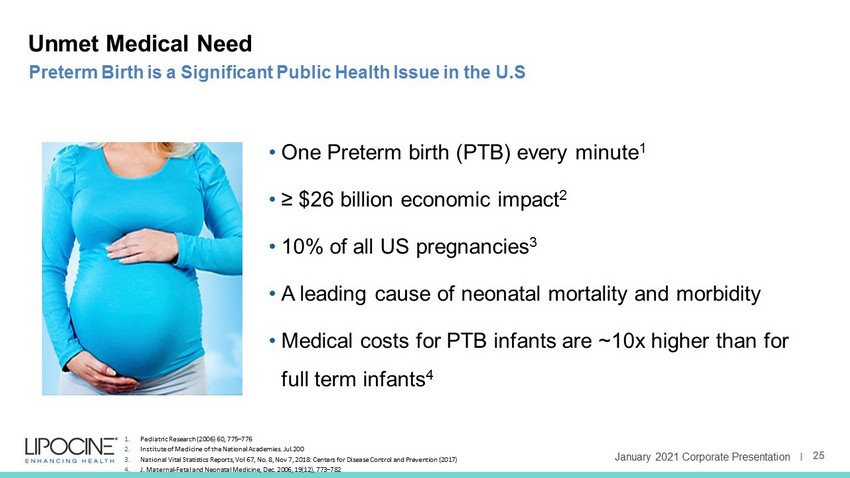
January 2021 Corporate Presentation I Unmet Medical Need • One Preterm birth (PTB) every minute 1 • ≥ $26 billion economic impact 2 • 10% of all US pregnancies 3 • A leading cause of neonatal mortality and morbidity • Medical costs for PTB infants are ~10x higher than for full term infants 4 25 Preterm Birth is a Significant Public Health Issue in the U.S 1. Pediatric Research (2006) 60, 775 – 776 2. Institute of Medicine of the National Academies. Jul.200 3. National Vital Statistics Reports, Vol 67, No. 8, Nov 7, 2018: Centers for Disease Control and Prevention (2017) 4. J. Maternal - Fetal and Neonatal Medicine, Dec. 2006, 19(12), 773 – 782

January 2021 Corporate Presentation I LPCN 1107: Potential To Be The Standard of Care for Prevention of PTB 26 Oral Hydroxyprogesterone Caproate (HPC) Convenient dosing No injection site reactions First oral enabling technology Solid IP coverage Orphan drug designated Next Step: Pivotal study agreement w/ FDA

January 2021 Corporate Presentation I Impact of Potential Market Withdrawal of Makena and Its Generics 27 An Opportunity for LPCN 1107 No approved standard of care for prevention of PTB Improved market potential Enriched target population: Not losing high risk patients to active control (injectable IM) May not require a non - inferiority study; Easier to recruit patients for placebo - controlled trial(s) Advanced “Phase 3 ready” oral candidate targeting PTB

January 2021 Corporate Presentation I Upcoming Milestones Near Term Value Drivers Event Expected Timing TLANDO™ Full Approval March 28, 2022 LPCN 1144 LiFT Primary Endpoint Results January 2021 LiFT Biopsy Results Mid 2021 28

January 2021 Corporate Presentation I Key Financial Metrics 29 Stock Price, Market Cap, Cash Balance Ticker Symbol LPCN (Nasdaq Capital Market) Closing Stock Price (12/28/20) $1.39 /share Cash Balance (9/30/20) $23.8 million Bank Debt (9/30/20) $6.4 million

Appendix
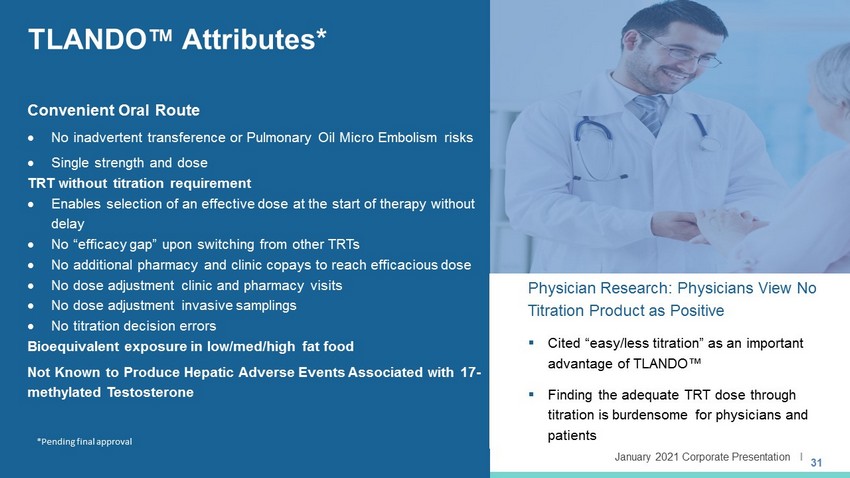
January 2021 Corporate Presentation I f TLANDO ™ Attributes* Convenient Oral Route No inadvertent transference or Pulmonary Oil Micro Embolism risks Single strength and dose TRT without titration requirement Enables selection of an effective dose at the start of therapy without delay No “efficacy gap” upon switching from other TRTs No additional pharmacy and clinic copays to reach efficacious dose No dose adjustment clinic and pharmacy visits No dose adjustment invasive samplings No titration decision errors Bioequivalent exposure in low/med/high fat food Not Known to Produce Hepatic Adverse Events Associated with 17 - methylated Testosterone 31 Physician Research: Physicians View No Titration Product as Positive ▪ Cited “easy/less titration” as an important advantage of TLANDO™ ▪ Finding the adequate TRT dose through titration is burdensome for physicians and patients *Pending final approval
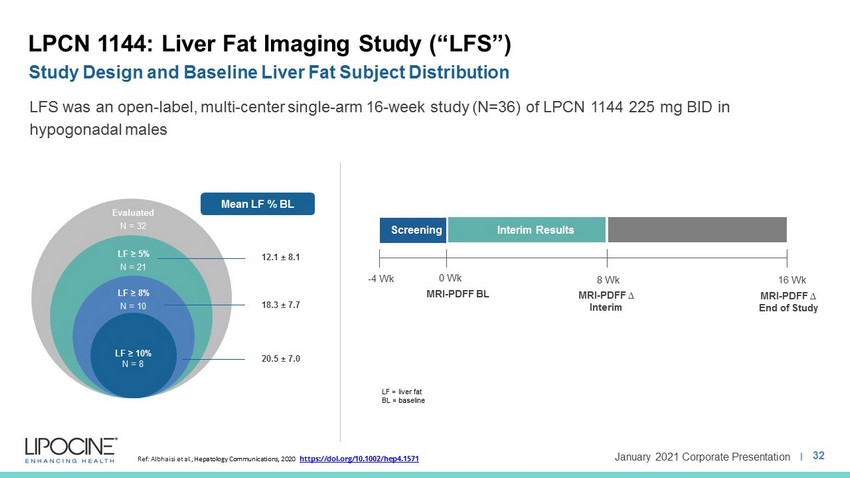
January 2021 Corporate Presentation I LPCN 1144: Liver Fat Imaging Study (“LFS”) Study Design and Baseline Liver Fat Subject Distribution LFS was an open - label, multi - center single - arm 16 - week study (N=36) o f LPCN 1144 225 mg BID in hypogonadal males LF ≥ 10% N = 8 LF ≥ 8% N = 10 LF ≥ 5% N = 21 Evaluated N = 32 20.5 ± 7.0 18.3 ± 7.7 12.1 ± 8.1 Mean LF % BL 32 Screening Interim Results - 4 Wk 0 Wk 8 Wk 16 Wk MRI - PDFF BL MRI - PDFF ∆ Interim MRI - PDFF ∆ End of Study LF = liver fat BL = baseline Ref: Albhaisi et al., Hepatology Communications, 2020 https://doi.org/10.1002/hep4.1571

January 2021 Corporate Presentation I LPCN 1148 in Cirrhotic Patients 33 References: Trivedi and Tapper, Gastroenterol Rep ( Oxf ), 2018; Berzigotti et al., Hepatology, 2017; Chen and Dunn, Clin Liver Dis (Hoboken), 2018; Sinclair et.al, Liver international, 2016; Neff et al., Digestive Diseases and Sciences, 2004; Puliyel et al., Australian and New Zealand Journal of Medicine, 1977; Brown et al., Cleve Clin Q, 1960; Girolami M, Am Geriatr Soc, 1958; Neff et al., Transplant Proc, 2004; Wells R., The Lancet, 1960; Yurci et al., Clinics and Research in Hepatology and Gastroenterology, 2011; Muting D., Verh Dtsch Ges Inn Med, 1969; Gluud C., Liver, 1984. *individual's health condition as it is influenced by the intake and utilization of nutrients • Reduce fat mass and increase muscle mass and strength • Increase bone density • Inhibit myostatin • Improve nutritional status* Anabolic • Induce hematopoiesis • Improve sexual dysfunction Androgenic • Reduce IL - 1, IL - 6, and TNF - α Anti - Inflammatory • Lower infection rate Improve immuno - dysregulation • Increase free T SHBG lowering 33 Potential Key Effects

LPCN 1107 Prevention of Preterm Births Enabling Oral Drug Delivery to Improve Patient Compliance 34

January 2021 Corporate Presentation I Preterm Birth (PTB) • Risks of adverse outcome for preterm infants rise sharply with decreasing gestation • Early PTB babies have higher rates of death and disability ▪ PTB <35 week has ~6x more relative death risk in first 28 days than full term babies 35 Basic Facts Source: National Perinatal Information System/Quality Analytic Services; www.npic.org. From: March of Dimes Perinatal Data Center, 2011 * : Behrman et al. Preterm Birth: Causes, Consequences, and Prevention. Washington, DC: The National Academies Press, 2006, 329 - 354 Economic Impact of PTB on the US Health System

January 2021 Corporate Presentation I Status of MAKENA and its Approved Generic Equivalents ● Confirmatory (PROLONG) study failed to verify clinical benefit and FDA concluded that the available evidence does not show that Makena is effective for its approved use ● CDER has issued a notice of opportunity for a hearing to AMAG Pharmaceuticals and approved generics to Makena for an opportunity to comment ● Makena and its approved generics will remain on the market until the manufacturers decide to remove the drugs or the FDA Commissioner mandates their removal ● FDA intend to hold a meeting with experts in obstetrics, neonatal care, and clinical trial design to discuss how to facilitate development of effective and safe therapies to treat preterm birth ● Eight approved ANDAs referenced Makena as the basis of submission. Upon withdrawal of Makena’s NDA, FDA would also withdraw all eight of ANDAs for drug products containing hydroxyprogesterone caproate that reference AMAG’s NDA as their reference listed drug CDER Proposes Withdrawal of Approval for Makena on October 5, 2020 36

January 2021 Corporate Presentation I Impact of HPC Plasma Concentration on PTB rate 37 PK - PD Correlation: HPC Concentration and PTB Rate 1 1. Caritis et al., Am J Obstet Gynecol. 2014 (N=315 subjects) 2. Ctrough for IM HPC Cavg , Makena • Lower % (~4.3%) PTB rate can be expected with daily Cavg2 ≥ 8.2 ng/mL compared to overall PTB rate • 25% of MAKENA (IM HPC ) patients with 250 mg/week dosing have levels below the desired “threshold critical for efficacy”
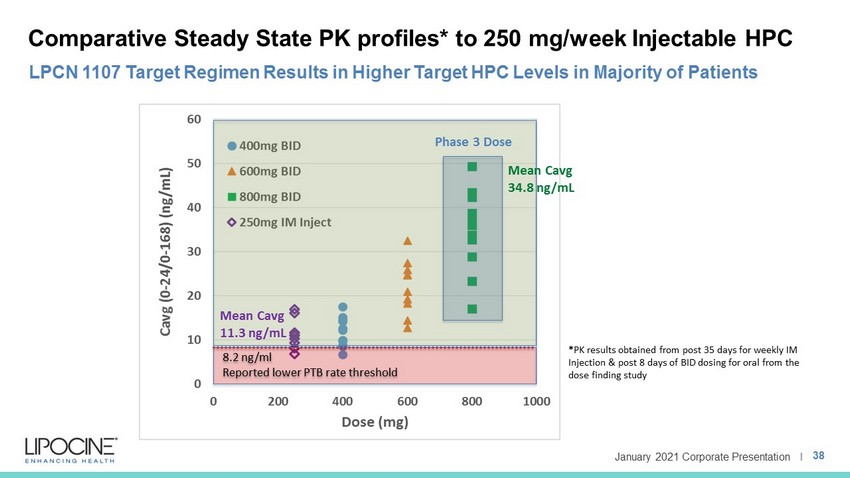
January 2021 Corporate Presentation I Phase 3 Dose Mean Cavg 34.8 ng/mL Mean Cavg 11.3 ng/mL 8.2 ng/ml Reported lower PTB rate threshold Comparative Steady State PK profiles* to 250 mg/week Injectable HPC LPCN 1107 Target Regimen Results in Higher Target HPC Levels in Majority of Patients * PK results obtained from post 35 days for weekly IM Injection & post 8 days of BID dosing for oral from the dose finding study 38
